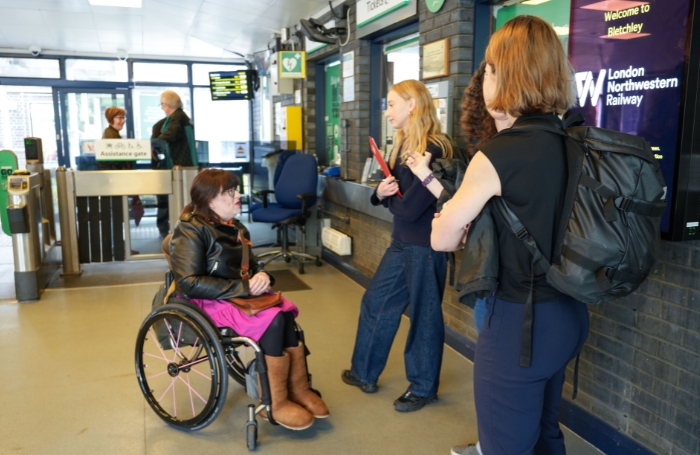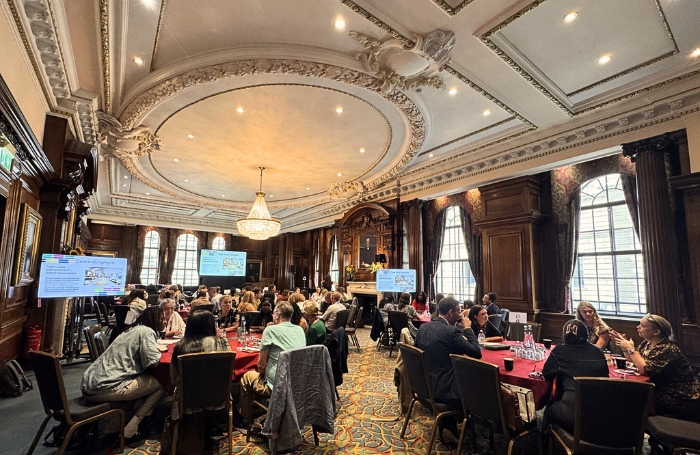The Inclusive Design Overlay (IDO) to the RIBA Plan of Work is now two years old and has established itself, particularly among many of the industry’s biggest clients, for successfully bringing a more rigorous approach to inclusion.
The overlay was designed to be more than just a checklist. The set of guidelines was recognised by the profession as a landmark methodology that, for the first time, set out all of the steps needed to embed inclusive design into project and programme delivery, and actively involve the right people at the right time. This means not just the design team and key stakeholders like client, project management team members and those in the design team, but also users and visitors of the project and different communities.
Around the second anniversary of the overlay's launch, we recently hosted an Inclusive Design Overlay Conference at the office of the Institute Of Civil Engineers, where attendees from other built environment bodies, practices, and clients discussed how access and inclusion can be embedded into design and work stages from the beginning, the implementation of the overlay, and how it has impacted the industry.
Following the conference, we caught up with one of those clients using the IDO to ensure inclusivity at the heart of their project to hear what they had to say.

What are some of the key principles in the IDO?
RIBA’s Inclusive Design Overlay underlines integrating inclusive design principles throughout the entire building lifecycle, from initial concept to ongoing use, rather than being an after-thought.
The key principles in the IDO include:
- Holistic approach. The Overlay urges going beyond the minimal legal requirements to ensure designs are inclusive in both letter and spirit.
- Create environments where everyone feels safe and welcome. Prioritise intuitive navigation and wayfinding, and design space that support independent use for all.
- Early engagement. The IDO advocates for incorporating inclusive design considerations right from the outset in order to avoid costly retrofits and miss key voices.
- Client and project team involvement. The IDO outlines specific tasks and responsibilities for different project roles to help foster a collaborative approach to inclusive design.
- Inclusive design lead. The IDO explains the role of an Inclusive Design Lead (or champion) to help in every project. It also sets out frameworks for an inclusive design strategy and an inclusive design outcome review.
- Beyond accessibility. The IDO highlights considerations that go beyond physical accessibility – neurodivergence, cognitive, sensory and social needs, faith and gender, for example.
- Documents. Documenting the inclusive design process is crucial for demonstrating compliance, but also for retaining the inclusive design strategies and outcomes as part of the ongoing use, management and maintenance.
Download RIBA's Inclusive Design Overlay

How is East West Railway Company using the IDO?
The latest major project benefitting from the IDO is the new rail link between Oxford and Cambridge, which is in the process of being delivered by the East West Railway Company (EWR Co) in three stages. Crucially for people with disabilities who will use the line there will be a mix of upgraded, relocated, and brand new stations that cater to their needs.
Georgina Taylor, EWR Co’s Accessibility Manager, says the team always had a vision for inclusive design from the outset: “We have always wanted to make sure that whatever we build will work for the people who are going to use the railway, but that’s such a broad spectrum of people with different needs. We have been working to keep inclusive design at the forefront of everyone’s mind.”
Once Georgina and her team had finalised their own set of inclusive values, they turned to the IDO to not only confirm they were on the, ahem, right track, but also help them with the way forward.
To help inform the process, EWR Co recruited an Accessibility Advisory Panel (AAP) of 12 people who live along the route, all with lived experience of traveling with different types of disabilities. The panel is thought to be the first of its kind to work with a design team at the outset of building a new railway.
Members of the AAP were invited to draw up a list of priority measures they would like to see at stations, starting with step free access through stations, accessible toilets on trains and at stations, and level boarding that could be unassisted. However, they went much further, with calls for accessible timetables and information boards, removal of ticket barriers for disabled passengers, scrapping the need to pre-book accessible parking places and much more that could easily have been overlooked.
Members of the panel then visited stations to be remodelled or still to be built and were joined by members of EWR Co’s design teams and architects MWJV (a joint venture between WSP and Mott Macdonald).
It was a real eye opener for some of the architects and members of the design team who had never participated in such an exercise, Georgina recalls, particularly when design assumptions were challenged, such as why access ramps had to be placed at the rear or to the side of station buildings, automatically treating people with disabilities as a second-class of passenger who don’t enjoy the same welcoming entrance as everyone else.
Read more about how and why architects should implement inclusive design into projects.

How to be smart when implementing inclusive design
Incorporating inclusive design into a project this size is about being smarter, Georgina says.
“[Being smarter] isn’t about cost necessarily,” she continues, citing one of the major misconceptions clients have when confronted with suggestions for more inclusive features and amenities. “You’re still providing the same things but giving them more thought. For instance, if you need a ramp put it in a place that makes people feel welcome. If you need to include signage, make sure it’s in the right place for everyone.”
In order to help make these decisions, the IDO offers clients a ready made management process they can apply to new projects, which is quite different from the usual static inclusive design checklist.
The overlay also sets out separate Plan of Work pathways for the client team, the client’s project management team, and design, construction and, asset management teams. The aim is that every professional supporting the project management function should be able to identify their own tasks at any stage of project delivery to help deliver the inclusive design vision.
Additionally, the IDO can be usefully applied at every work stage, and as one stage progresses to another, the overlay recommends a pause for review to ensure that inclusive design objectives are continuing to be met, and have not been neglected or lost during the previous stage.
Georgina says the IDO is providing the EWR Co team and its supporting teams with a structured management framework they can check against to ensure they are capturing everything they need to do to realise their inclusive design vision.
Thanks to Georgina Taylor, East West Railway Company.
Text by Neal Morris. This is a Professional Feature edited by RIBA Practice team. Send us your feedback and ideas.
RIBA Core Curriculum topic: Inclusive environments.
As part of the flexible RIBA CPD programme, professional features count as microlearning. See further information on the updated RIBA CPD core curriculum and on fulfilling your CPD requirements as a RIBA Chartered Member.









